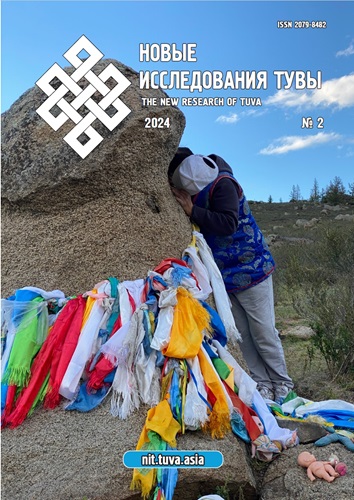Single-parent families in Tuva and Kazakhstan: a statistical and demographic view of the problem
DOI:
https://doi.org/10.25178/nit.2024.2.15Keywords:
illegitimate birth rate; family structure; single-parent family; single motherhood; single-parent practice; socialization of children; Republic of Tuva; KazakhstanAbstract
The article presents a comparative analysis of the statistical and demographic characteristics of single-parent families in Tuva (Russia) and Kazakhstan at the present stage. It considers the key factors that influence the prevalence of these families. The sources used are the All-Russia Population Censuses of 2010 and 2020, as well as the National Population Censuses of the Republics of Kazakhstan in 2009 and 2022. The article also uses materials on current demographic statistics, including gender characteristics, fertility rates, life expectancy, marriage patterns, divorce rates, and economic situations and income stratifications of different family types in Tuva and Kazakhstan.
As a result of socio-demographic transformations, both Tuva and Kazakhstan have seen an increase in single-parent households, but the proportion of nuclear single-parent households in Kazakhstan is higher than in Tuva. The quantitative gender differentiation in the structure of the modern population is more pronounced in Tuva compared to Kazakhstan, which in turn affects the marriage structure of the population. In Kazakh society, the rate of marriage is higher than in Tuvan society. In Tuva, the proportion of unregistered marriages is more than double that of Kazakhstan, which has a negative impact on the quality of family life for the population.
It has been shown that there are significant differences in the structure and typology of reasons for the formation of single-parent households in Tuva and Kazakhstan. Public censure and stigmatization of illegitimate births and single parenthood are more common in Kazakh society. Both societies have a high birthrate, but there are significant differences in out-of-wedlock and adolescent fertility rates, which lead to the formation of single-parent families. These rates are higher in Tuva.
Divorce is equally common in both regions, leading to single-parent households. These families are at risk of poverty and social instability, especially for those raising multiple children, children with disabilities, or with a low level of education.
References
Andreeva, E. M., Bychkov, D. G. and Feoktistova O. A. (2018) The Microeconomics of Social Protection of Families With Small Children in Russia. Ekonomika Truda, vol. 5, no. 4, pp. 1359–1374. (In Russ.). DOI: https://doi.org/10.18334/et.5.4.39482
Antonovich, I. V., Remneva, N. S. and Khuvuskaal, A. A. (2013) Comparative analysis of social work with single-parent families in the Republic of Tyva and the Altai Territory. In: Innovative practices of social work with the family / I. V. Antonovich et al. Barnaul, Izd-vo Altaiskogo gosudarstvennogo universiteta. 224 p. Pp. 177–212. (In Russ.).
Goncharova, G. S. and Savel'ev, L. Ya. (2004) Family and marriage relations among the peoples of Siberia: problems, trends, prospects / ed. by Yu. V. Popkov. Novosibirsk, Nonparel'. 286 p. (In Russ.).
Grishina, E. E., Tsatsura, E. A. (2023) Targeted allowances for children aged 3–7 and 8–17: accessibility, effectiveness and lessons for unified benefit. Population, vol. 26, no. 3, pp. 77–92. (In Russ.). DOI: https://doi.org/10.19181/population.2023.26.3.7
Dobrokhleb, V. G. and Efanova, O. A. (2023) Family potential as a component of the human potential of Russian regions. Population, vol. 26, no. 4, pp. 99–109. (In Russ.). DOI: https://doi.org/10.19181/population.2023.26.4.9
Elamanova, A. S. and Avsydykova, K. A. (2021) Socioreadaptation of young single mothers in the conditions of crisis centers (on the example of Almaty). The Journal of Psychology & Sociology, no. 3 (78), pp. 124–134. (In Russ.). DOI: https://doi.org/10.26577/JPsS.2021.v78.i3.11
Kuular, A. M. (2018) The resilience of adolescents from single-parent families on the example of the Republic of Tyva. In: Scientific works of Tuvan State University: a collection of materials of the annual scientific and practical conference of teachers, staff and graduate students of TuvSU. October 20, 2018, Issue XVII / ed. by U. V. Ondar. Kyzyl, Izd-vo TuvGU. 247 p. Pp. 179–181. (In Russ.).
Lamazhaa, Ch. K. and Mainy, Sh. B. (2020) Tuvan Wedding Rites: from Establishment of Family Ties to Social Presentation. Oriental Studies, no. 13 (2), pp. 405–421. DOI: https://doi.org/10.22162/2619-0990-2020-48-2-405-421
Mikheeva, A. R. (2008) On the causes of the ultra-high illegitimate birth rate among the indigenous peoples of Siberia: facts and hypotheses. In: Economics of Russia and Siberia: past, present, future: materials of the scientific conference dedicated to the 50th anniversary of the Institute of Economics and Industrial Production SB RAS / ed. by V. V. Kuleshov. Novosibirsk, Izd-vo Instituta ekonomiki i organizatsii promyshlennogo proizvodstva SO RAN. 290 p. Pp. 276–281. (In Russ.).
Natsak, O. D. (2022) Transformation of the Reproductive Model of the Tuvan Family: Historical Retrospective and Current Trends. Sotsiologicheskaia nauka i sotsial'naia praktika, vol. 10, no. 2 (38), pp. 52–71. (In Russ.). DOI: https://doi.org/10.19181/snsp.2022.10.2.9028
Natsak, O. D. (2023) Single-parent families and single-parent practices of women in modern Tuvan society. Abakan, Khakasskoe knizhnoe izdatel'stvo im. V. M. Torosova. 240 p. (In Russ.).
Pritvorova, T. P., Gelashvili, N. N. and Temirbaeva, D. M. (2023) Updating Kazakhstan's monetary poverty indicator system. Ekonomika Tsentral'noi Azii, vol. 7, no. 2, pp. 135–150. (In Russ.). DOI: https://doi.org/10.18334/asia.7.2.117784
Rostovskaia, T. K., Khasbulatova, O. A. and Smirnova, I. N. (2022) Social portrait of single mothers in Russian society: conceptual approaches. Zhenshchina v rossiiskom obshchestve, no. 4, pp. 15–21. (In Russ.). DOI: https://doi.org/10.21064/WinRS.2022.4.2
Rostovskaia, T. K., Khasbulatova, O. A. and Smirnova, I. N. (2023) Single mothers in Russian society: strokes to a social portrait. Zhenshchina v rossiiskom obshchestve, no. 1, pp. 32–42. (In Russ.). DOI: https://doi.org/10.21064/WinRS.2023.1.3
Seitova, G. T. and Pritvorova, T. P. (2008) Child poverty in the Republic of Kazakhstan: status and coping strategies. Izvestiia vysshikh uchebnykh zavedenii. Sotsiologiia. Ekonomika. Politika, no. 1, pp. 93–96. (In Russ.).
Smirnov, V. M. and Selivanova, O. V. (2023) Single-parent household in Russia: scale, problems and social assistance. Ekonomika Truda, vol. 10, no. 5, pp. 695–714. (In Russ.). DOI: https://doi.org/10.18334/et.10.5.117824
Temirbaeva, D. M. and Legostaeva, A. A (2020) Households with children in Kazakhstan: the model of reproduction and the dynamics of income. Ekonomika Tsentral'noi Azii, vol. 4, no. 4, pp. 288–310. (In Russ.). DOI: https://doi.org/10.18334/asia.4.4.41223
Agadjanian, V, Dommaraju, P. and Nedoluzhko, L. (2013) Economic fortunes, ethnic divides, and marriage and fertility in Central Asia: Kazakhstan and Kyrgyzstan compared. Journal of Population Research, no. 30, pp. 197–211. (In Russ.). DOI: https://doi.org/10.1007/s12546-013-9112-2
Banerjee, P., Chacko, S. and Piya, B. (2020) Paradoxes of Being and Becoming South Asian Single Mothers: The Enclave Economy, Patriarchy, and Migration. Women, Gender, and Families of Color, vol. 8, no. 1, pp. 5–39.
Cleuzio, J. and McBrien, J. (2020) Marriage quandaries in Central Asia. Oriente Moderno, no. 100, pp. 121–146. DOI: https://doi.org/10.1163/22138617-12340246
Kollmeyer, C. (2012) Family structure, female employment, and national income inequality: A cross-national study of 16 Western countries / LIS Working Paper Series, no. 579. Luxembourg, Luxembourg Income Study (LIS). 23 p.
Published
How to Cite
For citation:
Rostovskaya T. K., Natsak O. D. and Elamanova A. S. Single-parent families in Tuva and Kazakhstan: a statistical and demographic view of the problem. New Research of Tuva, 2024, no. 2, pp. 243-262. (In Russ.). DOI: https://doi.org/10.25178/nit.2024.2.15
Issue
Section

This work is licensed under a Creative Commons Attribution-NonCommercial 4.0 International License.

Author(s) license holder(s) grant rights for their work to the journal (grantee of a license) under the simple non-exclusive open license in accordance with Art. 1286.1 «Open license for a research work, work of literature or fine arts», Civil Code of the Russian Federation.
New Research of Tuva publishes articles under the Creative Commons Attribution-NonCommercial license (CC BY-NC).
Since it is an open license, author(s) reserve the right to upload the article to their institutional repository, submit it to another journal (if it allows republications), or republish it on their own website (in full, or in part).
However, several conditions apply here:
a) The republished version must always contain the name(s) and affiliation(s) of the author(s), the original title and the hyperlink to the original version on the New Research of Tuva website;
b) It must be in open access, free of charge, and no category of readers must be in any way whatsoever advantaged over general readership.
c) should the contribution be submitted elsewhere by its author(s) without substantial modification (30% or more of original text unchanged), the body of the article should contain a disclaimer that the original version was published in New Research of Tuva (with a link to the respective page)
The CC-BY-NC is a non-revocable license which applies worldwide and lasts for the duration of the work’s copyright.











